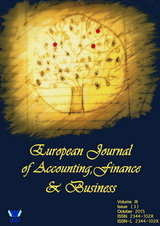|

ISSN: 2344 - 102X
ISSN-L: 2344 - 102X
Our journal is currently indexed in the following databases:
|
| |
Article from Volume 3, Number 3, Year 2015| EMPLOYEE BENEFITS AND PRODUCTIVITY: A STRUCTURAL EQUATIONS APPROACH | 
Download | | Author(s): Maria Moraru, Margareta Caran, Gratiela Georgiana Noja | | DOI: 10.4316/EJAFB.2015.336 | | Abstract: The analysis conducted within this paper aims to identify and assess the determinants and economic consequences of a specific type of employee benefits granted by companies after employment, respectively the pension systems and associated advantages, for Romania and Serbia, during 2005-2013. Our empirical research is based on developing several models processed through structural equations with the MLE (Maximum Likelihood Estimator) method. Furthermore, we used a complex set of indicators specific for the pension systems, as well as for the economic activity, labor market and education. The results obtained after processing eight macroeconometric panel and time series models highlight the importance of the economic activity in both countries which can significantly shape the pension systems. Thus, the economic growth reduces the number of pension beneficiaries for all types of pensions (old-age, anticipated old-age, survivor), representing an incentive for workers to remain actively integrated into the labor market. The main differentials between Romania and Serbia within this perspective are given by the educational level and the effects on labor and resource productivity, respectively its significant reduction in Romania and improvement for Serbia. | | Keywords: Employee Benefits, IAS 19, Pensions, Productivity, Economic Growth | References:
1. Bender Keith (2009), „How Are Pension Integration And Pension Benefits Related?”, The Quarterly Review Of Economics And Finance, Issue 49, Pp. 26–41.
2. Caran Margareta, Noja Gra?iela Georgiana (2015), „Employee Benefits In Multinational Firms: Empirical Evidence For Romania And Serbia”, Megatrend Review (Megatrend Revija), Vol. 12, Issue 2/2015, Pp. 155-170, ISSN 1820-3159.
3. Clark Robert, Morrill Melinda Sandler, Vanderweide David (2013), „Defined Benefit Pension Plan Distribution Decisions By Public Sector Employees”, Journal Of Public Economics, Pp. 1- 16.
4. Dorsey Stuart, Cornwell Christopher, Macpherson David (1998), „Pensions And The Labor Market”, în Pensions And Productivity, Kalamazoo, MI: W.E. Upjohn Institute For Employment Research, Pp. 1-12.
5. Freeman Richard (1985), „The Effect Of The Union Wage Differential On Management Opposition And Union Organizing Success”, NBER Working Papers No. 1748, National Bureau Of Economic Research, Pp. 1-12.
6. Kecmanovic Milica (2012), „Men’s Wage Inequality In Serbia’s Transition”, Economic Systems, Issue 36, Pp. 65–86.
7. Lazear Edward (2000), „Performance Pay And Productivity”, American Economic Review, American Economic Association, Vol. 90(5), Pp. 1346-1361.
8. Lin Jo-Hui, Wong Jehn-Yih, Ho Ching-hua (2013), „Promoting Frontline Employees’ Quality Of Life: Leisure Benefit Systems And Work-to-leisure Conflicts”, Tourism Management, Issue 36, Pp. 178-187.
9. Mitchell, O. S., Moore J. F. (1998), „Can Americans Afford To Retire? New Evidence On Retirement Saving Adequacy”, The Journal Of Risk And Insurance, 65(3), Pp. 371?400.
10. Maria Moraru, Rodica Blidi?el, Dan ?tirbu (2008), ” Case Study Over The Employee's Benefîts (IAS 19) And Pension Plan Accounting (IA S26) ”, Editura Universitaria Craiova, România, ISBN 968-606-510-162-3, Pp. 1450-1459, Conferin?a Interna?ional? "Competitivitate ?i Stabilitate într-o Economie Bazat? Pe Cunoa?tere", Rev. Categ. B+
11. Vukovi? Drenka, Periši? Natalija (2012), Pensions, Health Care And Long-term Care, Annual National Report 2012 – Republic Of Sebia, European Commission DG Employment, Social Affairs And Inclusion, Pp. 1-45.
12. *** International Accounting Standard 19 – IAS 19 – Employee Benefits (Standardul Interna?ional De Contabilitate 19 – Beneficiile Angaja?ilor).
13. *** International Accounting Standard 26 – IAS 26 – Accounting And Reporting By Retirement Benefit Plans (Standardul Interna?ional De Contabilitate 26 – Contabilizarea ?i Raportarea Planurilor De Pensii).
14. *** Casa Na?ional? De Pensii Publice, Serviciul Proiecte, Studii ?i Analize, Statistici Lunare Pilonul I.
15. *** European Commission, Eurostat Database, EU LFS, National Accounts, Labour Market, Demography - Population.
16. *** Statistical Office Of The Republic Of Serbia.
17. *** National Institute Of Statistics Of Romania.
|
| | Back to journal ... |
|
|
| |
|
|
|

